War Memorial Stadium (Buffalo)
| The Rockpile | |

Main entrance (left field corner) in 2011,
at Dodge Street and Jefferson Avenue |
|
| Former names | Roesch Memorial Stadium (1937) Grover Cleveland Stadium (1937–1938) Civic Stadium (1938–1960) |
|---|---|
| Location | 285 Dodge Street Buffalo, New York |
| Coordinates | 42°54′18″N 78°51′22″W / 42.905°N 78.856°WCoordinates: 42°54′18″N 78°51′22″W / 42.905°N 78.856°W |
| Owner | City of Buffalo |
| Operator | City of Buffalo |
| Capacity | • 33,000 (1937) • 35,000 (1939) • 46,500 (1960) |
| Surface | Natural grass |
| Construction | |
| Broke ground | 1935 |
| Opened | 1937 |
| Expanded | 1960 |
| Demolished | 1988 (partially) |
| Construction cost |
$3 million ($50 million in 2017 dollars) |
| Tenants | |
|
Buffalo Indians/Tigers (AFL) (1940–1941) Buffalo Bills (AAFC) (1946–1949) Buffalo Bills (AFL/NFL) (1960–1972) Buffalo Bisons (EL/AA) (1979–1987) Bishop Fallon High School (Monsignor Martin Athletic Association) (1962–1969) |
|
War Memorial Stadium (affectionately known as The Rockpile) was an outdoor stadium in the northeast United States, located in Buffalo, New York. It hosted both minor league baseball and professional football teams, most notably the Buffalo Bills of the American Football League (AFL), and later National Football League (NFL).
The stadium was on a rectangular block near the downtown area and its baseball diamond had an unorthodox southeast alignment (home plate to center field). The main entrance was in the left field corner at Jefferson Avenue to the east and Best Street to the south (behind right field). Its other boundaries were Dodge Street to the north (behind third base) and Masten Park to the west (behind first base) with Masten Avenue farther west. The east-west alignment of the football field was also unorthodox, running along the third base line.
War Memorial Stadium was originally constructed as a WPA project in 1937. It was originally named Roesch Memorial Stadium, though the name was changed to Grover Cleveland Stadium later in 1937 (honoring the former President and Buffalo public official) and then to Civic Stadium in 1938. The name was changed to War Memorial Stadium in 1960.
The stadium originally sat 35,000, but many expansions took place over the years, raising the capacity to over 46,500. Despite this, by the time of the AFL-NFL merger it was one of the smallest stadiums in the league (below the league's new 50,000-seat minimum). After considering and ultimately rejecting a move to Seattle, the Bills left after the 1972 season for Rich Stadium, now known as New Era Field, which had a capacity of over 80,000.
The stadium hosted the Buffalo Bills of the American Football League, and later the National Football League from 1960–1972, the unrelated Buffalo Bills of the AAFC from 1946–1949 ("Bisons" in 1946), the Buffalo Indians and Chiefs of the third American Football League in 1940 and 1941, Canisius College's baseball and football teams, and baseball's Buffalo Bisons of the International League during the 1960s and again from 1979–1987 (as part of the Eastern League and American Association).
...
Wikipedia
